Hunted: The Demon’s Forge is a fantasy action game heavily rooted in cooperative play developed by inXile. You might remember one of this developer’s games from the past known as the Bard’s Tale, which was a well received RPG. This time, however, they aren’t aiming for an in depth RPG experience. Instead, inXile has decided to combine the classic dungeon crawl experience of old RPGs with a more modern style to match the intensity of modern-day shooters.
Hunted’s lead roles consist of two mercenaries: Caddoc, the brutish melee master, and E’lara, an elven marksman. While the characters come off as cliché at first they show that they break the mold once you get into the game. Although Caddoc has a tough demeanor, he tends to be the cautious one and is easily scared by insects. E’lara constantly makes fun of him for his actions and takes on the energetic and fearless role. This unusual duo have set out on a quest given to them by a mysterious woman, who continually appears in Caddoc’s dreams, in exchange for a large payout. From here the two characters face various deadly obstacles as they try to complete their task as well as figuring out the mystery surrounding the Deathstone.
Here are the HOTs and NOTs.
HOT
Gameplay
First off, let’s make something clear. Hunted: The Demon’s Forge is not a true RPG targeted at the hardcore fans of that style of game. If you’re fond of games like Baldur’s Gate and you’re hoping for a similar experience, then chances are you will find yourself severely disappointed. We’re talking less RPG elements than Dragon Age 2 included and that game received some mixed feelings on its watered down mechanics. Hunted is an action game first and an RPG second. If you keep that in mind, you may find that you can enjoy the game for what it really is. Hunted may fall under the “hack ‘n slash” title, but it tends to escape the genre’s usual shortcomings for the most part. InXile wanted to make the action competitive with other high-octane genres and they do fairly well in this regard. The gameplay is addicting and, although the melee attacks consist of the same combos, the game rarely feels overly repetitive. It’s very similar to the feeling you get when playing a shooter. You may be shooting enemies one after another for hours on end in the same manner, but the overall experience is enjoyable and, therefore, the game doesn’t become monotonous.
As Caddoc, players will be taking on the tank role mainly dishing out damage at close range with melee weapons. Axes, swords, maces, and clubs are generally what Caddoc will be swinging around depending on what you find. Since E’lara is the marksman character it is only fitting that her expertise lie in bows and arrows. Much like Gears of War, if an enemy is injured to the point of falling down to their hands and knees a finisher can be performed. Caddoc has a few variations depending on his equipped weapon, but it usually ends with a decapitation. E’lara can execute her finisher from afar sending an arrow, which the camera trails behind closely, in the head of the kneeling foe. Both characters have access to melee, ranged, and magic attacks in order to change tactics on the fly, but they’re most effective when using their specialized weapons. For example, Caddoc can pull out a crossbow to help out with distant enemies, but the weapon takes a while to reload between shots making him less useful than E’lara in these situations since she can fire her arrows rapidly. If E’lara finds herself being closed in on by enemies she’s able to pull out a shortsword and shield to defend herself. The difference is in attack power/effectiveness. Also, even though Caddoc and E’lara can enjoy all 3 forms of combat, they tend to pick up new weapons that they specialize in. Caddoc replaces his melee weapon and shield (and the occasional piece of armor such as a pauldron) most of the time with new crossbows coming later on and E’lara switches out for new bows while keeping her normal shortsword and small shield on her until the player has advanced far enough to be rewarded with upgraded secondary weaponry. As for magic, there are 2 types: weapon and battle magic. Both of these are limited by your mana gauge. Weapon magic differs between the characters since they have different styles for fighting enemies. As you would expect, E’lara’s abilities alter her bow (ex: explosive arrows) and Caddoc is granted new melee moves (ex: charge attack). Battle magic is the same for both characters consisting of Brimstone, Sigil of Pain, and Dragon’s Breath. There are three tiers to each power and three upgrades on each tier for a total of nine upgrades to be applied to max out their respective abilities.
One area the game does feel RPG-esque is in the looting aspect. Treasure, weapons, shields, etc lie around every corner and in every breakable object (pots, statues, weapon racks). Gold is collected to advance through the tiers and unlock new items for the Crucible, which we will get to later. Crystals are treated as experience points and will be used for upgrading different abilities. Dragon Tears are the real treasure here as they allow players to utilize Battle Charge and, later on, Spell Link. These come in handy throughout the game as you become overwhelmed with enemies. Looting wouldn’t be so rewarding if it didn’t require extra work on the player’s part to get better rewards. Items like Dragon Tears or unique weapons are usually obtained by finding secret paths or solving puzzles. Sometimes you will utilize the Deathstone to interact with dead bodies’ spirits or read tombs to find riddles that you must work out in order to get the ultimate prize. These side missions provide a fun distraction that is well worth the time you invest in them. The more you do the better chance you have at completing the Talent challenges. Similar to challenges seen in FPS games, completing certain tasks (killing 500 enemies combined for example) rewards the player with bonus slots and abilities that better prepare your warriors.
Cover System
I purposely omitted this from the above category because this deserves a dedicated section. When people think of hack n’ slash games cover systems are rarely included in that thought process. InXile has further blended genres by adding the ability to take cover in a type of game that has never had such a mechanic attached to it. By pressing X (A for Xbox 360) players can snap to cover to avoid incoming arrows or magic. Since E’lara is the weaker of the two characters the cover system works greatly to her advantage. While Caddoc softens up warriors E’lara can safely pick off other marksmen in the distance to keep her partner safe. The inclusion of such a mechanic drives home the point that this is definitely an action title inspired by some light RPG characteristics.
Cooperative Play
Hunted: The Demon’s Forge was built around the idea of co-op. While players are welcome to take on the game with computer-controlled AI, the game really shines when you’re playing with another human being. The game does a good job of making sure that people are working together. Caddoc can take a lot of damage when dealing with enemies in close quarters, but he his quickly taken down by long range attacks. The opposite is true of E’lara. This requires that players watch their partner’s back by taking care of the enemies they are best fitted to engage. Communication is key as tactics change on the fly making sure the melee and marksmen roles are being used to the best of their ability. With shields able to deteriorate and, eventually, break it is crucial that Caddoc receive substantial backup so that he isn’t left defenseless. But since arrows are limited E’lara will need her fair share of protection if she finds herself scavenging for ammunition. Team work reaches into death as well. While players can heal themselves if they have potions during combat, they cannot do anything except crawl around once they’re downed. As long as the living character has a revive vial they can help out their companion. The best part about this is that you don’t have to run over to your friend as he bleeds out. There isn’t too much time given before the player dies so, to save time, players toss the vials over a substantial distance which break on impact and revive their fallen buddy. If players feel like switching roles, they are welcome to do so at the obselisks located throughout the levels (this can also be done in single player). The game was made for two players and it definitely makes things run a lot smoother, especially puzzles.
Crucible
inXile added a wonderfully addictive mode to the game for players to enjoy long after they completed the story. Crucible is a map creator that lets players create their own arenas. You can alter the arena theme, 2 pick up slots, up to 3 waves (with three slots per wave), 4 mod slots, and your starting loadout. As you gain gold in Adventure mode it will unlock new tiers in the Crucible which, in turn, unlocks more options. Arena themes consist of both large and small maps to choose from depending on the type of battle you want. Pick up slots allow you to choose between Regen Vials, Health Bottles (Large), and Mana Bottles. As you progress, more intimidating enemies can be thrown into the fray such as minotaurs and a couple bosses. If you’re feeling lucky, you can add up to 300 enemies per wave which makes for some hectic and lengthy battles. Mod slots include “blessings” and “punishments” or, as they are more commonly known, modifiers. Switching these on can add time limits (punishment) or make arrows replenish over time (blessing). Since it’ll take a while to unlock the full set of creative options here, this mode has tons of replay value.
NOT
Dialogue
The dialogue exchanged between characters comes off as mindless at first, but eventually grows on you. Unfortunately, most of the dialogue present during gameplay gets old fast. By chapter 2, I had heard the same back-and-forth countless times between Caddoc and E’lara when she was asked to light her arrow on fire to solve a puzzle. Since most puzzles require fire arrows to solve, players will become all too familiar with the same three or so lines that are repeated throughout the game. Even the prisoners that are hidden in the game awaiting rescue repeat the same line over and over until you either find and free them or leave the area entirely. Additional dialogue would have done wonders to avoid this fatigue brought on early in the game.
Graphics
The graphics in Hunted are nothing spectacular. Actually, in the opening level the game looked very poor. Once the game changed the scenery to underground tombs and tunnel systems the graphics seemed much more bearable. This may have been due to the dim lighting though. Character models aren’t as smooth as is expected in games nowadays. Even some animations come off very stiff and result in awkward motions. A little more polish and the game would really shine as it has some interesting areas that are begging to be shown off in high detail.
Linear
Sometimes the game gives off the impression that it is more open than it really is. Seeing as how the game tries to promote exploration in order to find the game’s best loot and secrets, it can be disheartening to find some paths cut off prematurely by invisible walls. It would have been better to use physical objects to keep players on the right path instead of running into solid air as you try to effectively search your surroundings for loot.
AI
Whether you’re playing on your own or with a friend, you’re bound to see a few issues with that AI. In single player, your partner tends to be very reserved when it comes to combat. Cadddoc wasn’t too much of an issue since he attracted most attention of the enemies, but he still could have been more offensive. The real issue came with E’lara. She wasn’t too productive in taking out the enemy archers. They usually tore me apart before she took out a majority of my attackers. The problem wasn’t present during every fight, but it did happen at crucial moments where Regen Vials were not in either our inventories. Other AI glitches can be seen in the enemy from time to time. At one point I found an attacker facing away from me running into a barrier endlessly. It’s definitely better to enjoy the game with a friend to avoid this problem almost entirely.
Spell Tree
Even though this is an action title it would have been better to see a more in depth skill tree or at least different battle magic between Caddoc and E’lara. Upgrading the same 3 spells three different times may be rewarding in the sense that they are more useful, but it leaves the player wanting more. It had the potential of adding more cooperative tactics to the mix by incorporating role-specific spells that compliment each character.
Verdict
inXile took a hack n’ slash genre, one that has gone missing lately, and put a modern spin on it. The action oriented gameplay comes off strong and entertaining, but don’t expect anything revolutionary. The cover system, being the most noticeable addition, has dungeon crawl fans taking a whole new approach to combat. Also, the well-paced story and Crucible mode will ensure that players enjoy the game for quite some time. With cooperative play taking center stage here you’ll enjoy numerous hours of gaming working out the best tactics with your friends. The game starts to fall short of expectations in the graphics aspect and various limitations (spell tree, linearity, and so on). AI is also a fault, but it isn’t as much of an annoyance as dialogue since it isn’t too original or varied. Overall, Hunted: The Demon’s Forge offers a fresh experience for an old genre and, while it falls short in some areas, it is definitely a welcome change of pace that will hopefully perfect its formula the second time around.
[Editor’s Note: Hunted: Demon’s Forge was reviewed on the PlayStation 3 hardware. The game was provided to us by the publisher for review purposes]

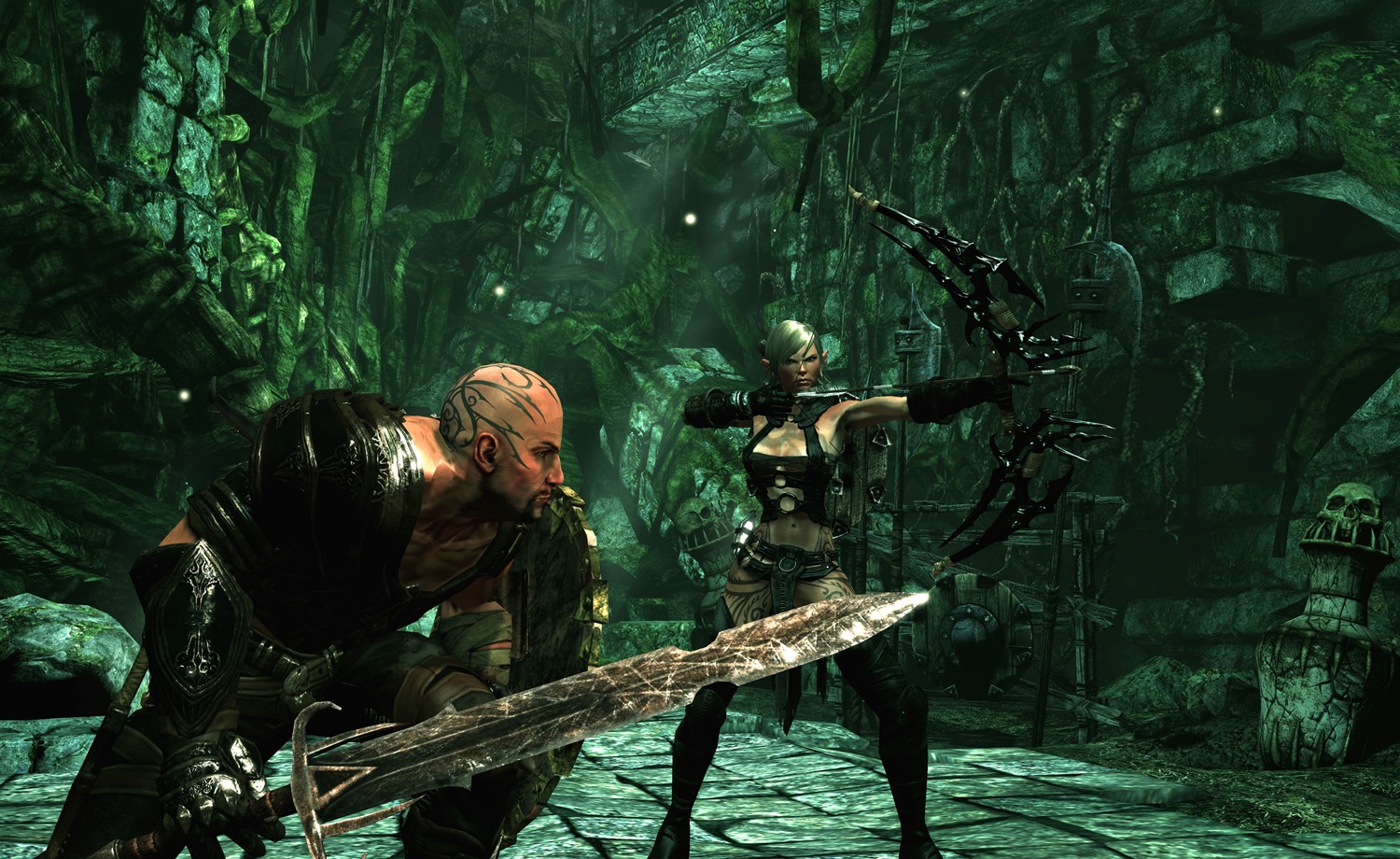
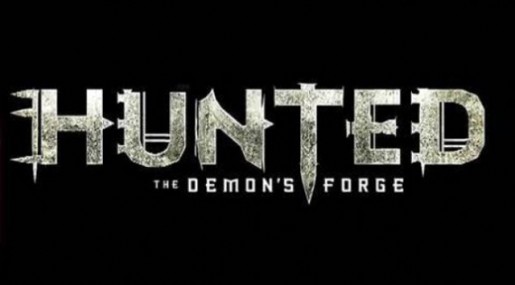
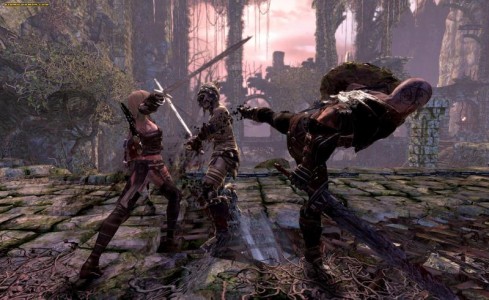
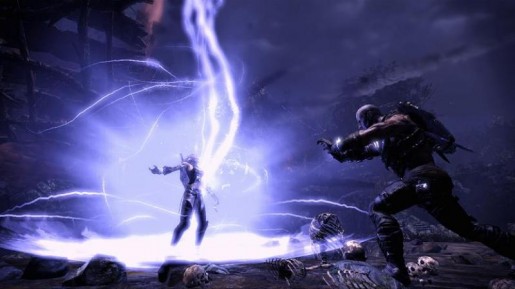
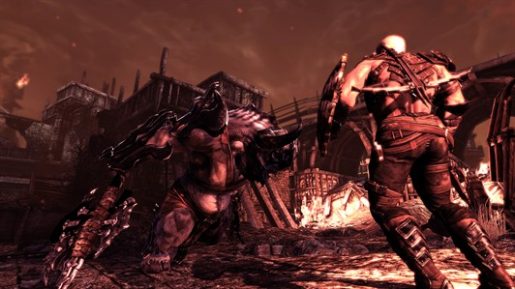
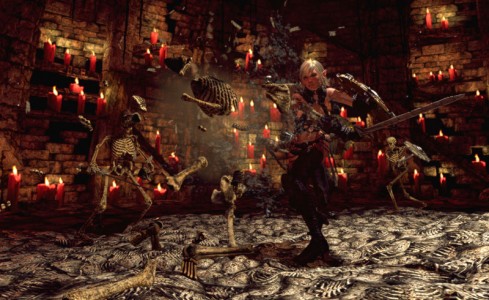
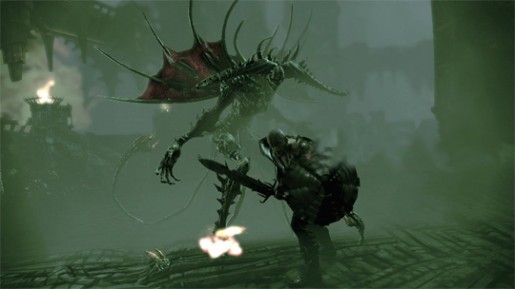
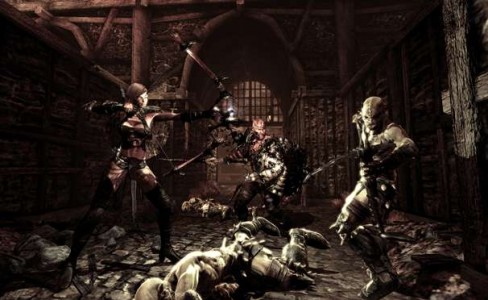
desfunk
June 2, 2011 at 5:33 PMI like to call this game “Medievil Army of Two”, cause that’s what it feels like.
Most of the points you made are pretty spot on with my feelings towards this game. The graphics are especially disappointing. Not in that they’re bad. But more-so that they’re overly generic and the lighting just seems ‘off’. Some areas seem too bright, while others seem too dark.
I’ve only made it to act 2 so far though. So i’m hoping it might pick up as the game goes on. If not, i’ll just stick through it to hear Xena talk to me! lol